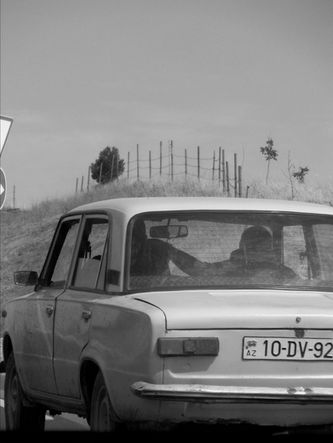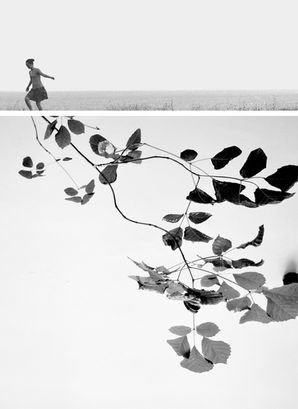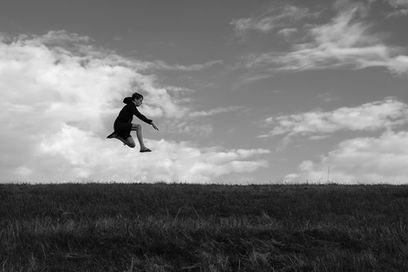
LIFE IN QRIZ
May 24, 2021
INTERVIEW
PHOTOGRAPHY Fidan Nazimqizi
INTERVIEW Melanie Meggs
When we think of life, we often imagine a kaleidoscope of experiences, emotions, and memories. But for photographer Fidan Nazimqizi, life is seen through the lens of her camera. Through her black and white photography, she captures the raw energy, feelings and inspiration of everyday life on the street, creating a unique and captivating perspective.
Fidan is a passionate traveler, taking her camera with her on her journeys and reflecting her own vision of reality in each of her photographs. Over the last three years, photography has become an integral part of Fidan's life, changing her outlook on the world. As part of her series 'Life in Qriz', Fidan shares her photographs with the world, inviting viewers to explore the beauty and emotion of the everyday of the Qriz community.

“When I'm out taking a photograph, I will not only see but also experience the environment - smell the earth, feel the breeze on my skin, or even hear the sounds around me.”
IN CONVERSATION WITH FIDAN NAZIMQIZI
THE PICTORIAL LIST: Fidan, please talk to us about your series of photos - LIFE IN QRIZ.
FIDAN NAZIMQIZI: Qrız is a village and in the Quba Rayon of Azerbaijan. Quba is a city and the centre of the Quba District of Azerbaijan. The city lies on the north-eastern slopes of Shahdag mountain. The city itself is home to a number of architectural and historic monuments, like the Juma Mosque, Gilgilchay Fortress, and a number of other mosques and mausoleums. Many people come to Quba as part of a trip to other parts around the city. Red Town is the world’s last surviving shtetl, a settlement of Mountain Jews with their own language and culture. Khinalug is the highest village in Azerbaijan, 2,350 m (7,710 ft) above sea level. Khinalug was isolated from the rest of the world for most of its history, leading to unique stone buildings and a language spoken nowhere else.
Quba is also popular just as a place to go to enjoy the beautiful nature of Azerbaijan. Quba carpets also make for an interesting trip. These carpets feature intricate designs that take inspiration from nature and geometric patterns, plus a variety of vivid colors. Each village had signature patterns, though many have been lost to time. However, more recently, carpet workshops have been opening in Quba with the aim of bringing back the art of carpet weaving and reviving the skills and knowledge needed to keep this ancient art alive.
The village of Qrız sits on a plateau over 2,000 metres up surrounded by dramatic landscapes. They speak their own local language. Qrız language is part of the Caucasus family, in the Dagestan group and the Shahdag sub-group. Their houses are made partly out of picked wooden sticks and stones in the near forests. It is not possible to get to the village by a personal car, only by foot or 4x4 Land Rover. Locals usually earn a living by keeping animals and grazing them. However, the village of Qrız is still the cradle of Qrız identity and culture. It’s history, relying on the little online information that exists, as well as interaction with several locals, is undoubtedly very rich.
The Qrız people are reportedly descendants of one of the 26 tribes that made up Caucasian Albania, the ancient state that existed between the 4th century BC and the 8th century AD and encompassed today’s Azerbaijan. Evidence of this is the abundance of old stones from crumbled houses and graves scattered across the plateau on which Qrız sits, which give some idea of the village’s scale in its prime. There is a ancient mosque located in the center of the village. Some Baku hike-tour companies use the village as a base to visit a local waterfall that is especially attractive when frozen in winter.
TPL: Tell us about yourself. How did you become interested in photography?
FN: Born in the city of Baku, Azerbaijan, I live in Baku. I work as accountant but like photography so much. I have always been interested in photos. When I was younger, I used to pore through drawers of photos and photo albums that my parents made, looking at them, rearranging them and remembering the moment that they were taken. Little did I know that those pictures would someday help shape a great hobby of mine and something that would bring me great joy.
TPL: Do you have any favourite artists or photographers you would like to share with us, and the reason for their significance?
FN: I find my inspiration from old and vintage photographs. Vivian Maier and her black and white photos have always inspired me.
TPL: What do you want to express through your photography? What are some of the elements you always try to include in your photographs?
FN: I think my way of seeing will reflect in my choice of the element. When I'm out taking a photograph, I will not only see but also experience the environment - smell the earth, feel the breeze on my skin, or even hear the sounds around me. I use my camera to express my own interpretation of that real event and environment.
TPL: Do you have a favourite place to go photograph?
FN: Into the hue of the nature and city, I always find myself calm. Most of the time I try my best to capture it in my camera. That is what my rules of work is all about - people and nature - reflecting my own vision as evidence of reality. My notions of what is worth looking is arranging elements and making compositions.
I discovered that my camera helped improve my life. Concepts that definitely changed my way of thinking.

TPL: When you take pictures, do you usually have a concept in mind of what you want to shoot, or do you let the images just 'come to you', or is it both?
FN: I discovered that my camera helped improve my life. Concepts that definitely changed my way of thinking - when I take a photograph, I will not only see but also experience the environment.
TPL: Does the equipment you use help you in achieving your vision in your photography? What camera do you use? Do you have a preferred lens/focal length?
FN: During 2018 I used to shoot with my Nikon D3100 (18-55mm) only. Nowadays I use a Yashica 35 GSN and Canon 85N with a 35mm. I also use some old cameras: a Fujifilm JZ100 (25-200mm), Kodak STAR EF (35mm).
TPL: What happens when you go out with your camera? What is your process? Do people respond positively to you, or do you sometimes get negative reactions? If yes, how do you handle it?
FN: I take my camera everywhere and I have tried to take a photo every day for a year. I no longer saw the same streets I walk along everyday, with the same people, and the same thoughts in my head. Sometimes people don’t like when I do photographs. This reason I take photos hidden. Sometimes they ask me take photos too. Different people and different viewing angle.
TPL: What are some of your goals as an artist or photographer? Where do you hope to see yourself in five years?
FN: Over the last three years, photography has helped me live life a lot better and completely change my perspective on the world. I hope learning and growing too.
TPL: Are there any special projects you are currently working on that you would like to let everyone know about?
FN: I'm a member of the BerlinExplorer project. A project of ideas and creating an immersive photography experience. BerlinExplorer wants to be an open-door activity and accessible to anyone who wants to gain experience in photography, it is not a closed circle, but an opportunity to grow in a community open to the exchange of ideas and experiences. Creator of this project Emiliano Vittoriosi also did my fanzine “Saudade”.
Also I work on my personal project 'Handmade Vintage Papers' and prints photography.
TPL: When I am not out photographing, I (like to)…
FN: When I am not out photographing, I explore 1940-70’s photographs.









































